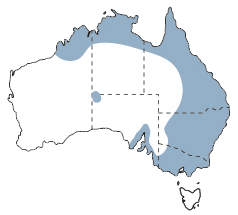SPECIES INFORMATION
IntroductionText version (.docx 33kB) This species is also commonly called the blue tongue lizard. Physical and behavioural characteristics
Environmental requirements for keeping in captivity
|
Natural distribution
Feeding and nutrition Base diet
Enhancements
Considerations when keeping blue-tongue lizards in schools
|
ReferencesTurner, G. (2001) Keeping blue-tongue lizards. Australian Reptile Keeper Publications |
|


